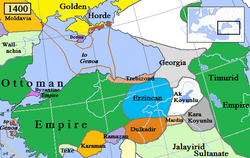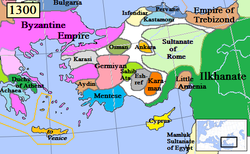Anatolské bejliky
| Anatolské bejliky Tavâif-i mülûk Anadolu beylikleri
| |||||||||||||
Geografie
| |||||||||||||
různá | |||||||||||||
| Obyvatelstvo | |||||||||||||
| Státní útvar | |||||||||||||
Vznik | |||||||||||||
Zánik | 16. století – poslední bejlik anektován Osmanskou říší | ||||||||||||
| Státní útvary a území | |||||||||||||
| |||||||||||||
Anatolské bejliky (turecky Anadolu beylikleri, osmansky Tavâif-i mülûk) nebo turecké bejliky v Anatolii jsou souhrnná označení pro skupinu drobných tureckých knížectví ve středověké Anatolii (Malé Asii) po pádu Seldžucké říše a předcházející Osmanské říši. Osmanský stát byl původně jedním z anatolských bejliků.


Původ bejliků sahá až od konce 11. století, kdy byli správou nad různými částmi Seldžucké říši pověřováni regionální vládci zvaní bejové. Vznik relativně nezávislých knížectví souvisí se zánikem Seldžucké říše a zejména pak s rozpadem Rúmského sultanátu způsobeným vpádem Mongolů v druhé polovině 13. století. Tento proces pokračoval také ve století následujícím. Politicky slabé rozdrobené bejliky uvolnily prostor k vytvoření nové říše. Dočasně se v oblasti prosadil Mongoly založený Ílchanát, původně součást mongolské veleříše. Historicky předcházely Osmanské říši, kterou založil bej Osman Ghazi, jeho malé knížectví s územím okolo města Söğüt bylo tedy jedním z těchto anatolských bejliků. Osman pokračoval v nájezdech proti slábnoucí Byzanci, přičemž se vyhnul konfliktu s jeho silnějšími tureckými sousedy. Za jeho nástupců osmanský stát zesílil natolik, aby si mohl podmanit další drobná knížectví a sjednotit je do mocné říše.
Seznam anatolských bejliků

Anatolské bejliky s vlajkami dle Katalánského atlasu:
 Ajdin (1300–1425)
Ajdin (1300–1425)- Ahiler (asi 1290–1362)
- Ahis (1230–1392)
 Alanye (1293–1471)
Alanye (1293–1471)- Bafra (14. století–1460)
 Canik (kolem 1330–1460)
Canik (kolem 1330–1460)- Çubuk (1085–1112)
- Danišmendovci (1071–1178)
- Dilmaç (1085–1398)
 Dulkadir (1348–1522)
Dulkadir (1348–1522) Eretna (1335–1390)
Eretna (1335–1390)- Erzinkan (1379–1410)
- Eşref (13. století–1326)
 Germijan (1300–1429)
Germijan (1300–1429) Hamidovci (1300–1391)
Hamidovci (1300–1391)- Inalovci (1085–1183)
- Chobánovci (1211–1309)
 Kandar (1291–1461)
Kandar (1291–1461) Karaman (1250–1487)
Karaman (1250–1487) Karası (1296–1357)
Karası (1296–1357)- Lâdik (1262–1391)
- Limnie (14.–15. století)
- Mengüjek (1072–1277)
 Menteşe (1261–1424)
Menteşe (1261–1424) Osmanský bejlik (od 1299)
Osmanský bejlik (od 1299) Teke (1321–1423)
Teke (1321–1423) Ramazánovský bejlik
Ramazánovský bejlik- Sáhib Atovci (1275–1341)
- Saltukovci (1072–1202)
 Sarukhan (1300–1410)
Sarukhan (1300–1410)- Šáhští Arméni (1110–1207)
- Sinopský bejlik (1277–1322)
- Smyrna (1081–1098)
- Tanrıbermiş (1071–1098)
Reference
Související články
Externí odkazy
 Obrázky, zvuky či videa k tématu Anatolské bejliky na Wikimedia Commons
Obrázky, zvuky či videa k tématu Anatolské bejliky na Wikimedia Commons
Média použitá na této stránce
According to Rıza Nur, sultan Selim I (1512-20) had a white personal flag, while the Ottoman Army flag was red (kızıl bayrak). During Süleyman I's reign (1520-66) the janissaries had a white flag while the timariot cavalry had a red flag. It was used as the Ottoman civic and merchant flag from 1793 to 1923.
A Flag that represents the Ilkhanate of the Mongol Empire in the Catalan Atlas, a primary source created in 1375. Actual use of this flag by the Ilkhanate is not confirmed by other sources.
Autor:
Assets from File:Possible Flag of the Kingdom of Alodia (c. 1350).svg and File:Ondas heráldicas.svg, Licence: CC BY 4.0
Depiction of the flag of the Beylik of Teke from the Catalan Atlas. A very similar depiction is in the Book of Knowledge of All Kingdoms.
Autor: Pontic2006, Licence: CC BY-SA 4.0
The Flag of Armenian Lusignan dynasty, which was first submitted to the red-blue-yellow colors, in fact, had suffered changes: Added two were sharp and some star.
Autor: BlinxTheKitty, Licence: CC BY-SA 4.0
Possible flag or banner of the Ottoman Empire (or Ottoman army) according to Hieronymus (aka Jérôme) Bosch (crwflags.com), the painter lived in the Middle Ages (c. 1450–1516) in Brabant and some of his paintings show Ottoman flags. These are generally red with a white crescent. It was the end of the XVth century, when the Ottomans had just conquered Constantinople and thus ended the Byzantine Empire, that was a shock for the Christian world.
Anatolian Beyliks in the Catalan Atlas (1375)
Autor: Gabagool, Licence: CC BY 3.0
Trebizond and surrounding states in Anatolia/Caucasus in AD 1400. (Partially based on Euratlas map of Europe, 1400, improved since Koza Yayınları Tarih Atlası sf.42; Kanaat Yayınları Tarih Atlası sf.28; Mutafian, Claude & Van Lauwe, Eric: Atlas historique de l'Arménie, Autrement publ., coll. «Atlas/Memoires», Paris 2001, ISBN 2-7467-0100-6 and since the graphic style of [1])
Autor: Gabagool, Licence: CC BY 3.0
Map of the Anatolia region in AD 1300. (Partially based on Euratlas map of Europe, 1300.)
Autor: Original uploader was Ingoman at en.wikipedia, Licence: CC BY-SA 3.0
Flag of Candar according to the Catalan Atlas of 1375, created by Ingoman AKA James Dahl. WARNING: This image is highly speculative. The main source pointing to this design is the Catalan Atlas, which as a historical primary source cannot be considered a reliable reference, especially if it is the only source used. This image should not be added to articles without clearly indicating its speculative nature. Note that FOTW (where most of those flags on Commons are adapted from) is based on user contributions like Wikipedia, and hence not authoritative either.
Flag of Candar according to the Catalan Atlas of 1375. Flag of Eretnids Emirate (Principality) (Source: The Image of the World on Old Portolans. The Black Sea Littoral from the End of the 13th — the 17th Centuries (in Russian) by Igor K. Fomenko).
- WARNING: This image is highly speculative. The main source pointing to this design is the Catalan Atlas, (File:Abraham and Jehuda Cresques Catalan Atlas. Eastern Europe view from the south.C.jpg) which as a historical primary source cannot be considered a reliable reference, especially if it is the only source used. This image should not be added to articles without clearly indicating its speculative nature. Note that FOTW (where most of those flags on Commons are adapted from) is based on user contributions like Wikipedia, and hence not authoritative either.
Autor: Lord Leatherface na projektu Wikipedie v jazyce turečtina — English translation by Morningstar1814 (diskuse), Licence: CC BY-SA 4.0
Anachronistic map of the anatolian beyliks that have existed at different points in time between the 13th and 15th centuries.
Flag of the Afhsar Tribe and historical flag of Alaiye (modern-day Alanya) with Avsharid tamgha.
Flag of Semiso
Autor: Samhanin, Licence: CC0
Double-headed eagle of the Sultanate of Rum
Autor: SnowyMercury455, Licence: CC BY 4.0
Flag of Konya in the Book of Knowledge of all Kingdoms






















